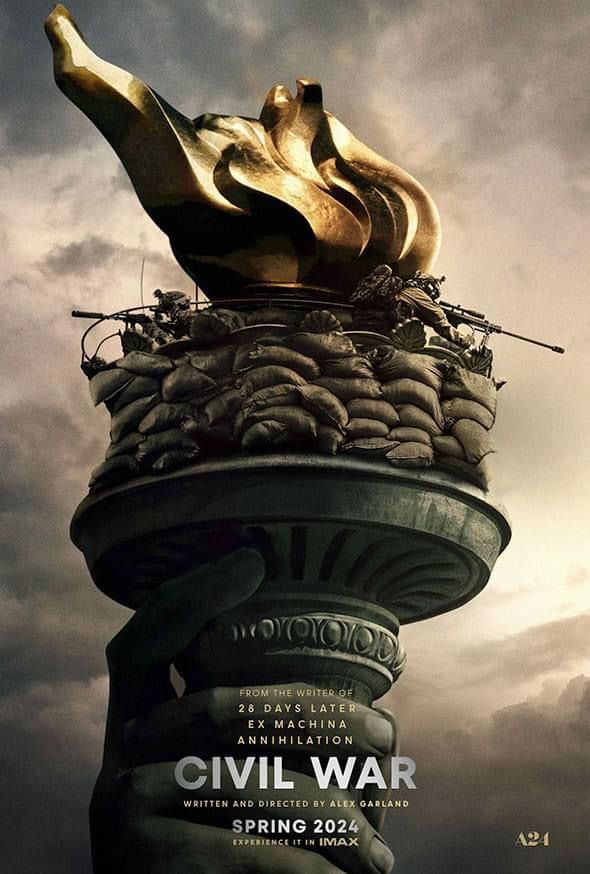
I didn’t want to see this because in the preview Jesse Plemons, who I think is the most menacing actor we’ve had in a great long while, asks an obviously foreign born American citizen, “What kind of American?” I mistakenly thought the entire movie was going to be something akin to The Killing Fields, which I think upset me to a degree only matched later by Silence of The Lambs.
But I had to trust Kirsten Dunst who rarely picks a wrong script and is, coincidentally, married to Jesse Plemons. She has acted with her husband before, in The Power Of The Dog.
So I went and was pleasantly surprised. The premise is that a tyrant President (Nic Offerman, of Parks and Recreations fame) has refused to relinquish power and is now serving a third term. He calls himself the President of the United States but his alliance is actually the “Loyalist States,” and its not at all clear that these states which include most of the northeast and midwest are loyal. It’s also notable that Trump’s main concern from his underlings is their loyalty. The movie opens with a massive violent demonstration in Brooklyn and ultimately a suicide bomber, and some of the dialogue makes it clear that the president has used troops on U.S. citizens. There are other alliances: the New People’s Army (mostly northern states), The Florida Alliance which includes all of the old south except South Carolina, and the Western Alliance which is Texas and California. It’s the Western Alliance that this story is concerned with. Because while the president goes on television and repeatedly lies that the secessionist states are completely defeated, in fact the WA has come within miles of Washington D.C. and are about to make a final offensive to capture or kill the rogue president.
He’s smart enough not to make the president a Trump parody, and in fact, we hardly see him very much. But the story, instead, follows a conflict photographer Lee (Kirsten Dunst) and a war reporter Joel (Wagner Moura), who decide to get to the president before he’s captured or killed. They have to go on a long roundabout way to get to Washington because of some vaguely mentioned problems with the direct route from NY to D.C. This means the trip will be roughly 580 miles and, basically the story becomes a road show through various places of horrible conflict. This includes the scene with Jesse Plemons, who turns out to be a white supremacist and with some fellow white supremacists, is executing anyone that isn’t born in America. He’s the most nightmarish of all the characters and the most excruciating to watch. But the scene doesn’t last too long.
What was interesting to me about this encounter is how the professionals are able to read what is happening. When they first encounter this group, a whole bunch of bodies are being dumped into a mass grave. Lee asks, “Are they in uniform,” and when the answer is “no,” Sammy (Stephen McKinley Henderson), the oldest man in the group and the one with the most experience says, “We have to leave. They do not want to be discovered.” I would never have thought to think about the clothing the bodies were wearing. But someone with experience did. And because Jessie (Cailee Spaeny) is a neophyte war reporter, a lot of what this movie is about is experience, aging, and the perpetually haunted. As Lee explains at one point, their job is to go look at the stuff other people (except soldiers) can’t see, and bring it back, so that people stop doing it. But they don’t stop doing it and Lee, who gives off the sense that she is at the end of her ability to keep going, knows that her job is pointless but still necessary.
Ultimately this is a movie about reporters and war photographers — not the tension in America or the wish fantasies of so many right wingers that we get on with it and have another civil war. In Africa, safaris used to be about killing animals or discovering the source of the Nile, for example. Later, the guns were replaced with cameras, and the photograhic safari is now dominant. But it’s still a form of hunting. In this movie, the link between the soldiers with guns and the photographers with cameras or reporters with pens and tape recorders is made clear.
The only thing I really disliked was the end, where Jessie gets someone killed because of her stupidity and possibly youthfulness, and then photographs that person as they die, and seems to be without remorse, because she gets up and runs deeper into where the action is. At the beginning she was someone I didn’t care about, but by the end, she was someone I hated.
The soundtrack is absolutely horrible, but it is meant to be that way. It’s meant to make you feel discomfort. And the special effects sounds are sometimes so screechingly loud it makes you want to stuff your ears. This is also intentional.
